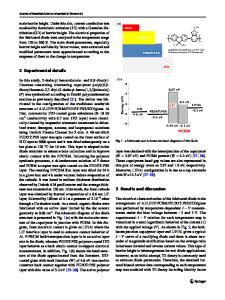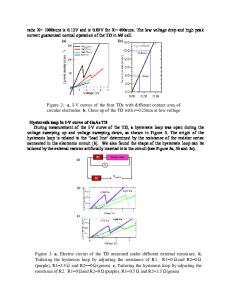Analysis of the Temperature Dependence of Diode Ideality Factor in InGaN-Based UV-A Light-Emitting Diode
- PDF / 589,229 Bytes
- 6 Pages / 612 x 792 pts (letter) Page_size
- 86 Downloads / 336 Views
HYSICS OF SEMICONDUCTOR DEVICES
Analysis of the Temperature Dependence of Diode Ideality Factor in InGaN-Based UV-A Light-Emitting Diode P. Dalapatia,*, N. B. Manika, and A. N. Basua a
Condensed Matter Physics Research Centre, Department of Physics, Jadavpur University, Kolkata, 700032 India *e-mail: [email protected] Received May 18, 2020; revised May 18, 2020; accepted June 9, 2020
Abstract—The temperature dependence of diode ideality factor in InGaN-based UV-A light-emitting diode has been investigated using the current–voltage characteristics at different temperatures. The obtained values of diode ideality factor are found to increase from 2.252 to 7.79 due to cooling down the device from 350 to 77 K. The evaluated values of diode ideality factors (even at high temperature) are greater than the expected values lying between unity to two. An attempt has been made to elucidate such greater value of diode ideality factor by existing theories as well as its effect on the diode characteristics. Keywords: InGaN UV LED, diode ideality factor, tunnelling current, current crowding effect DOI: 10.1134/S106378262010005X
1. INTRODUCTION Recently, the ultraviolet (UV) light-emitting diodes (LEDs) based on gallium nitride (GaN) have drawn excessive attention owing to their potential applications in photocatalysis, water purification, sterilization, banknote identification, solid-state lighting (SSL), etc. [1, 2]. Also, InGaN-based commercial LEDs being easily available in the market, various problems associated with III-nitride semiconductor light-emitting materials have been reported to date [1–3]. But an interesting query regarding the typical values for the diode ideality factor n in InGaNbased LEDs needs to address properly, as this electrical parameter is important to decide the dominant current transport. According to Sah–Noyce–Shockley (SNS) theory, the value of n is between unity and two [4, 5]. On the contrary, for InGaN|GaN multiple quantum-well (MQW) blue LEDs it is reported that n is higher than two and it varies from 1.9 to 6.2 (for medium-bias regions) due to change in temperature from 300 to 100 K [6]. These values are found to be significantly different from those expected from SNS analysis. Although Achariya et al. [7] reported that the value of n could be up to 3 and it depends on the carrier generation and recombination processes within the space charge region (SCR) of the p–n junction, but however, that is not discussed in detail. To account for the same, Shah et al. [8] developed a model considering the effect of metal contacts (i.e., the junctions behave like Schottky junctions) with the p–n junction. The metal contacts might be treated as the additional sources of diode ideality factors (factor).
In order to explain such high values of n, Masui et al. [4] have suggested an interesting experimental method to calculate n in InGaN-based LEDs where the effects of metal contact can be neglected. The authors have used the intensity of photoluminescence (PL) spectrum, particularly originating from t
Data Loading...











